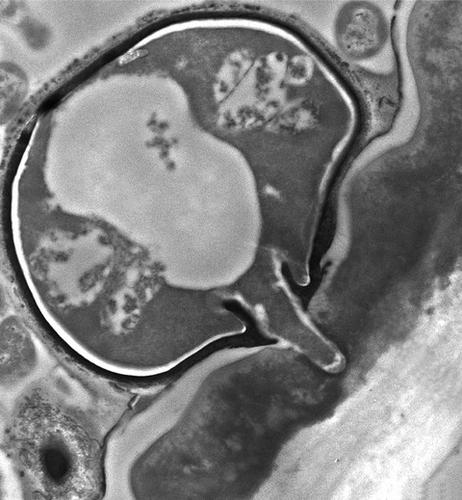当前位置:
X-MOL 学术
›
Plant Pathol.
›
论文详情
Our official English website, www.x-mol.net, welcomes your
feedback! (Note: you will need to create a separate account there.)
Histological and ultrastructural characterization of the leaf infection events of Colletotrichum fructicola on Malus domestica cv. Gala
Plant Pathology ( IF 2.3 ) Pub Date : 2020-02-03 , DOI: 10.1111/ppa.13141 Shengping Shang 1 , Xiaofei Liang 1 , Guangli Liu 1 , Song Zhang 1 , Zhongxin Lu 2 , Rong Zhang 1 , Mark L. Gleason 3 , Guangyu Sun 1
Plant Pathology ( IF 2.3 ) Pub Date : 2020-02-03 , DOI: 10.1111/ppa.13141 Shengping Shang 1 , Xiaofei Liang 1 , Guangli Liu 1 , Song Zhang 1 , Zhongxin Lu 2 , Rong Zhang 1 , Mark L. Gleason 3 , Guangyu Sun 1
Affiliation

|
Glomerella leaf spot (GLS), characterized by black necrotic spots and severe defoliation, is a destructive foliar disease of apple. Widely grown cultivars such as Gala and Golden Delicious are highly susceptible to GLS. Currently, the infection biology of the causal pathogen, Colletotrichum fructicola, on apple leaves is unclear. In the present study, the penetration and colonization processes of C. fructicola were characterized on apple (cv. Gala) leaves using light and transmission electron microscopy. C. fructicola conidia produced germ tubes 4 hours post‐inoculation (hpi) and appressoria at 8 hpi. In melanized appressoria, funnel‐shaped appressorial cones formed around the penetration pore. At 12 hpi, C. fructicola produced secondary conidia. After penetration, C. fructicola began to develop infection vesicles at 36 hpi. At 48 hpi, the primary hyphae of C. fructicola were produced from infection vesicles within host epidermal cells; the host epidermal cell plasma membrane remained intact, indicating a biotrophic association. Subsequently, secondary hyphae penetrated epidermal cells and destroyed cell components, initiating necrotrophic colonization. C. fructicola also produced biotrophic subcuticular infection vesicles and hyphae. Together, these results demonstrate that C. fructicola forms special infection structures and colonizes apple leaves in a hemibiotrophic manner, involving intracellular as well as subcuticular colonization strategies. Detailed characterization of the infection process of C. fructicola on apple leaves will assist in the development of disease management strategies and provide a foundation for studies of the molecular mechanism of the C. fructicola–apple leaf interaction.
中文翻译:

果炭黑炭疽病菌叶片侵染事件的组织学和超微结构表征。节日
Glomerella叶斑病(GLS)是一种破坏性苹果叶面病害,以黑色坏死斑点和严重落叶为特征。Gala 和 Golden Delicious 等广泛种植的品种对 GLS 非常敏感。目前,苹果叶子上的致病病原体Colletotrichum fructicola的感染生物学尚不清楚。在本研究中,C. fructicola 的渗透和定植过程在苹果 (cv. Gala) 叶子上使用光学和透射电子显微镜进行了表征。C. fructicola 分生孢子在接种后 4 小时 (hpi) 产生胚芽管,并在 8 hpi 产生附着菌。在黑色化的附着孔中,在渗透孔周围形成漏斗状附着锥。在 12 hpi,C. fructicola 产生次生分生孢子。穿透后,C. fructicola 在 36 hpi 开始形成感染囊泡。在 48 马力时,C. fructicola 的初级菌丝是由宿主表皮细胞内的感染囊泡产生的;宿主表皮细胞质膜保持完整,表明生物营养关联。随后,次生菌丝穿透表皮细胞并破坏细胞成分,开始坏死性定植。C. fructicola 还产生生物营养的皮下感染囊泡和菌丝。总之,这些结果表明 C. fructicola 形成特殊的感染结构并以半生物营养方式定植苹果叶,涉及细胞内和皮下定植策略。对苹果叶上 C. fructicola 感染过程的详细表征将有助于疾病管理策略的制定,并为研究 C. fructicola 的分子机制奠定基础。
更新日期:2020-02-03
中文翻译:

果炭黑炭疽病菌叶片侵染事件的组织学和超微结构表征。节日
Glomerella叶斑病(GLS)是一种破坏性苹果叶面病害,以黑色坏死斑点和严重落叶为特征。Gala 和 Golden Delicious 等广泛种植的品种对 GLS 非常敏感。目前,苹果叶子上的致病病原体Colletotrichum fructicola的感染生物学尚不清楚。在本研究中,C. fructicola 的渗透和定植过程在苹果 (cv. Gala) 叶子上使用光学和透射电子显微镜进行了表征。C. fructicola 分生孢子在接种后 4 小时 (hpi) 产生胚芽管,并在 8 hpi 产生附着菌。在黑色化的附着孔中,在渗透孔周围形成漏斗状附着锥。在 12 hpi,C. fructicola 产生次生分生孢子。穿透后,C. fructicola 在 36 hpi 开始形成感染囊泡。在 48 马力时,C. fructicola 的初级菌丝是由宿主表皮细胞内的感染囊泡产生的;宿主表皮细胞质膜保持完整,表明生物营养关联。随后,次生菌丝穿透表皮细胞并破坏细胞成分,开始坏死性定植。C. fructicola 还产生生物营养的皮下感染囊泡和菌丝。总之,这些结果表明 C. fructicola 形成特殊的感染结构并以半生物营养方式定植苹果叶,涉及细胞内和皮下定植策略。对苹果叶上 C. fructicola 感染过程的详细表征将有助于疾病管理策略的制定,并为研究 C. fructicola 的分子机制奠定基础。











































 京公网安备 11010802027423号
京公网安备 11010802027423号